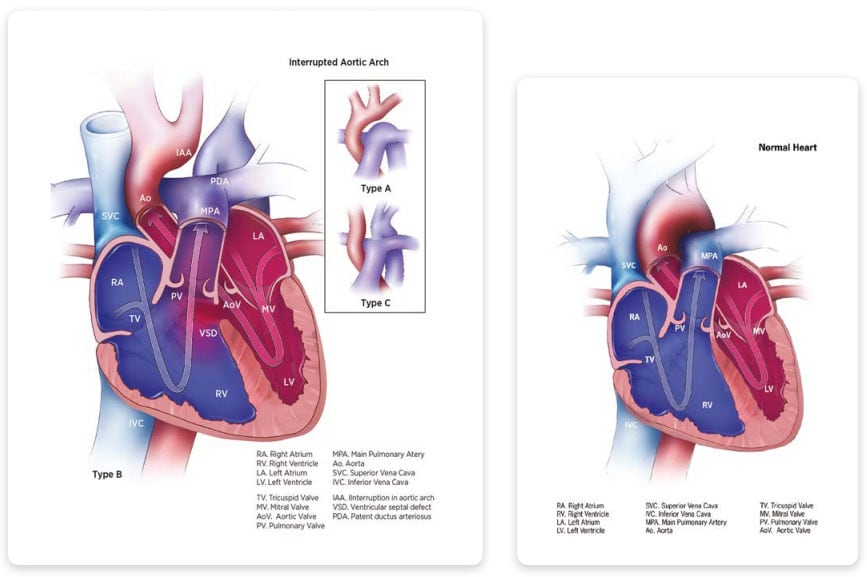

Interrupted aortic arch is an extremely rare anomaly in adult patients. Interrupted aortic arch is when the large blood vessel that takes blood away from the heart to the rest of the body (aorta) is not fully developed. The suspicion of coarctation of the aorta can be made from a combination of physical findings including systolic ejection murmur, the murmurs of collateral blood vessels, diminished or absent femoral pulse, and difference in blood pressure between arms and legs. About 30 percent to 40 percent of the infants with interrupted aortic arch have type A. They are grouped according to the area of the missing piece Type A: The interruption occurs just past the left subclavian artery. There are three types of interrupted aortic arch. In an interrupted aortic arch, part of the aorta is missing, leaving a gap. Interrupted aortic arch (IAA) means a missing portion of the aortic arch. Normally, it's shaped like an arch or curve. The aorta is the heart's main pipeline, carrying oxygen-rich blood to the body. Both right and left vertebral arteries (RVA. An interrupted aortic arch (IAA) is a rare heart condition that happens when the aorta doesn't form completely. (A, B) Volume-rendered CT images show discontinuity between the ascending aorta (AA) and descending aorta (DA) distal to the left subclavian artery (LSA) with a large patent ductus arteriosus (arrow) supplying the descending aorta.

This presents as a missing segment of the aortic arch and is divided into three types: A-called extreme form of coarctation, and is characterized by disruption of aorta's continuity distal to the left subclavian artery (30–40%), B-disruption between the left subclavian and the left carotid arteries (55–60%), and C-the most uncommon type, interruption proximal to the left common carotid artery. There is apparent interruption (INT) of aortic arch between left subclavian artery and descending thoracic aorta. CT angiogram in a 31-year-old woman with type A interrupted aortic arch. Interruption of the aortic arch is typically treated with surgery to repair the problems of the aorta, as well as other related heart problems.Interrupted aortic arch is a rare and usually lethal malformation, representing approximately 1% of congenital heart disease. What are interruption of the aortic arch care options? Signs and symptoms of interruption of the aortic arch usually occur soon after birth, frequently presenting with a heart murmur, a rapid heart rate, gray and cold feet and legs, shortness of breath, problems with feeding, and being more sleepy and unresponsive than normal. It occurs during fetal development, and infants that have it often have other heart defects, as well. Interruption of the aortic arch appears to be a genetic disorder. What causes interruption of the aortic arch? When blood flow is cut off at any point along this arch, it is known as interruption of the aortic arch or an interrupted aortic arch (IAA). Nonetheless, this condition has been identified later in adult life in rare cases. Part of the Aorta is absent and this leads to severe obstruction to blood flow to the lower part of the body. This is a very serious heart condition in which there is a complete blockage in the main artery (the aorta) which comes off the heart.

Early symptoms usually occur early in the neonatal period and clinical deterioration is often rapid and long-term prognosis is limited. Also known as: interrupted aortic arch, IAA What is Interruption of the Aortic Arch (IAA)?Īs the aorta carries blood from the heart to the rest of the body, it arches upward before bending around and down. Interrupted aortic arch is an extremely rare congenital malformation representing about 1 of congenital heart disease.


 0 kommentar(er)
0 kommentar(er)
